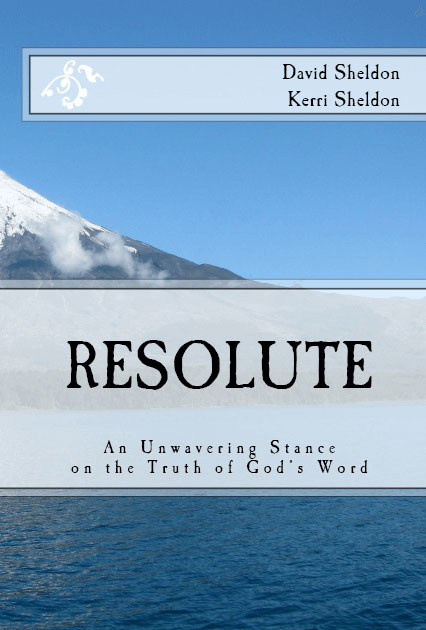The Jesus Storybook Bible
The purpose of reviewing The Jesus Storybook Bible is to decipher whether the author/editors of this children’s book are engaging in artistic license at their best or mixing the biblical message with lies. I will introduce a few questions and make some observations that will hopefully help us understand what is actually taking place here.
Let’s begin with the opening page of the book which says:
“God wrote, ‘I love you’ – he wrote it in the sky, and on the earth, and under the sea. He wrote his message everywhere! Because God created everything in His world to reflect Him like a mirror-to show us what He is like, to help us to know him, to make our hearts sing. The way a kitten chases her tail. The way red poppies grow wild. The way a dolphin swims. And God put it into words, and wrote it in a book called ‘The Bible’.”
Let’s stop right there. Is this true?
I would suggest there are four critical theological issues on this very first page of The Jesus Storybook Bible. They are:
1. God writes I love you by means of the creation.
2. That very creation reflects Him like a mirror.
3. We can know Him by looking at that reflection in the creation.
4. These previous 3 things are written in the Bible.
According to the author, all four of these things are true as she looks at and interprets Psalm 19:1-2. Would the Jesus of the Scripture be able to read those introductory statements and know that this was His Father that was being talked about? I do not believe so. Let’s look at each claim, in light of Psalm 19.
First, the author writes: “God wrote, ‘I love you’ – he wrote it in the sky, and on the earth, and under the sea. He wrote his message everywhere!” In order to accurately test this claim, we must first grasp what the 19th chapter of Psalms is stating.
Psalm 19 is divided into two sections: God’s works and God’s words. Verses 1-6 state that the works of God’s hands (ie. heavens, days, nights, sun) display His greatness, goodness, eternality, and omnipotence – using personification. The second section, verses 7-14, states that the words of God are perfect, sure, right, pure, true, and more desirable than gold.
Unfortunately, the author has looked at Psalms 19:1-2 and incorporated the concept that the works of God literally speak to us – that God put His words in His works. But this text states that nature displays or is proof of God’s greatness. It tells of God, of His powerful attributes. In this case, it specifically equates the glory of God in verse 1 as specific attributes of God seen using what He has created. It is not “speech” about His “love.”
Let me ask you, does Scripture ever state that God’s creation tells us of His love or that He speaks about His love through the creation? No. The truth is that God “wrote I love you” when He put Christ on the cross to redeem sinners from His holy wrath. He did more than just write it, He demonstrated it. (See The Gospel) Thus, the author has taken a passage that speaks of God’s greatness and uses it to introduce God’s love.
The next statement by the author, “Because God created everything in His world to reflect Him like a mirror…,” also causes a very serious theological problem. The word “reflect” means: To give back or show an image of; to reproduce. (Dictionary.com) So, for the author to say that creation reflects God like a mirror is to say that we can look at nature and we will see God in it. But, God is not “in” His creation in this sense. He is separate from it.
This brings us to the two biblical attributes of God – His transcendance and His immanence. God’s immanency or closeness does not contradict the fact that God is transcendent or different than His creation. We need to see these two biblical concepts as truth that is contradictory to Panentheism. Bob DeWaay says it very well in his article Romantic Panentheism, a Review of One Thousand Gifts by Ann Voskamp:
“That God is not limited spatially (there is nowhere where He is not – Psalm 139:7-10) is a valid, Biblical concept. But panentheism describes an ontological, not spatial category. Ontology is the study of being. It is the study of what something is in its essential nature. Panentheism teaches that God’s essence or being is in everything. This is not the doctrine of omnipresence (though it would affirm it).
If God in His essence and essential being is found in everything, then there is nothing unique about Christ (which is precisely the New Age claim). Biblically, nature does not reveal God and His glory in the same way Christ does. Nature reveals God obliquely and only in a condemning, not saving, way. Christ reveals God in His divine nature and speaks God’s inerrant words. Jesus spoke inerrant, binding words that will be our judge on the last day (John 12:48). The moon does no such thing.”
Creation is simply proof that there is a Creator and not a reflection of Himself. If we think we know Him through the creation, since the author states He is reflected in it, it gives false comfort.
In Romans 1 & 2, Paul talks about God, the creation, and the general revelation of God in every man’s conscience as a condemning thing rather than a comforting thing. Paul does not say that the creation itself gives knowledge of God nor that it shows God “in” it. In fact, Paul is saying that all mankind responds to God’s general revelation by rejecting Him and exchanges it for idolatry. It is only through His unveiling our eyes that we realize our sinful state and can come to God because of what Jesus has completed on the cross – special revelation.
The false doctrine of Panentheism attempts to “trump” the exclusiveness of the incarnation. Read the following texts of Scripture and ask yourself “Is God seen in the creation or is He only seen in the incarnate Son?”
John 1:18 “No one has seen God at any time; the only begotten God who is in the bosom of the Father, He has explained Him.”
Colossians 1:15 “He is the image of the invisible God, the firstborn of all creation.”
Hebrews 1:3a “And He is the radiance of His glory, and the exact representation of His nature…”
The truth is that it’s only in His Son that we can “see” the invisible God. Unfortunately, the author has just embedded her storybook bible in the belief known as panentheism which says that the universe is contained within God and that the universe is part of God. It is the view that God is in all, and yet He is greater than the all. It then follows that He can love us or reveal Himself through this creation since He is part of it. (For more on panentheism, see Panentheism, What is That?)
But, the Christian worldview is not that He somehow personally loves us in the creation or makes Himself known to us through the creation. Instead, we are separated from this God because we are “dead in our trespasses” (Eph 2:5). If He loves us through the creation, and He makes Himself known through that creation, why would we even need Jesus?
When I look at a pretty flower, I do not see an essence of God in that flower nor do I know him better having seen His creation. So, if He does not reflect Himself in that flower, for the author to say “…to show us what He is like, to help us to know him, to make our hearts sing. The way a kitten chases her tail. The way red poppies grow wild. The way a dolphin swims.” is a false concept.
So, when the author next states, “And God put it into words, and wrote it in a book called “The Bible”,” she has come to a false conclusion. Based on this first page of the book, the reader is now in the mindset that the Bible says they can look anywhere to see and know God, that He loves them by means of creation.
This sets the tone for the rest of The Jesus Storybook Bible, giving it a superimposed “feel good” disposition in which “Every story whispers his name” as the subtitle reads. Let’s pause right there. The word whisper means: to speak softly, or under the breath, so as to be heard only by one near at hand. Is that how God has told us He loves us? No, God did not romantically whisper that He loves us, but rather He demonstrated His love for us by having the Holy Lamb of God die on Calvary bearing the wrath of God for our sin.
The thought that God’s love is easily accessible and written everywhere is commonly known as Romanticism – an exaltation of the primitive and the common man, an appreciation of external nature, an interest in the remote, a predilection for melancholy. (Webster-Dictionary) The demonstration of God’s love on Calvary was not a romantic whisper. It was God loving His fallen creatures in a demonstration of His justice and mercy. This is the glory of God in His Son demonstrated to the world.
Now let’s take a look at the first story which is titled “The Terrible Lie” (starts on page 28).
“Eve picked the fruit and ate some. And Adam ate some, too. And a terrible lie came into the world. It would never leave. It would live on in every human heart, whispering to every one of God’s children: ‘God doesn’t love me.'”
The author’s explanation of “The Terrible Lie” is not the biblical explanation of Satan’s lie. The lie was actually Satan’s spin on what God said about eating the fruit of the Tree of the Knowledge of Good and Evil. The lie was not something that came into the world as a result of Adam and Eve disobeying and eating the fruit. It should be titled “The Terrible Fall,” not “The Terrible Lie.” The real question now is how could a Holy God love sinful creatures who rebelled against Him. Therefore, I reject the notion that the lie is something in a human heart that whispers “God doesn’t love me.” Unfortunately, the author has a spin on “The Terrible Fall.”
The reality is the author has introduced – to children – a different view of the God & Father of Jesus and a different understanding of the nature of the fall than the Bible does. As we have seen, there are some clear indications that the author is viewing Jesus’ Father as a Romantic Panentheistic Deity and the Fall as something altogether different than the Biblical description.
So which is most important: This “imported” myth that is the setting for the “Jesus” storybook bible? Or, the stories of Jesus in the Bible that give us a different picture, a different setting, the true setting of why the real Jesus had to come in the first place. Why should we settle for this “mixture” of lies? Is that the way to help our children know the true and living God?
If we are seeking to actually glorify the Lord Jesus Christ of the Scripture, why would we settle for introductory myth and ambiguity about God’s love and knowing Him through creation? Didn’t Christ get into serious trouble with fallen man because He came to make the name of His Father known? That very revelation given by Christ is being “defused” in the introductory statements!
Shouldn’t we warn about that instead of recommend it? What Jesus is it that would give this book an introductory “nod/whisper” to this characterization of His Father?
Why highly regarded evangelicals are recommending this book without pointing out these theological issues is rather disconcerting. I have seen two positive reviews: One is by Tim Challies on his blog and another is by Justin Taylor on The Gospel Coalition blog. However, you can read reviews similar to this one that point out the theological errors: one is by Cody Libolt on Pulpit and Pen, and another is by Josh Niemi on Expository Parenting Ministries.










